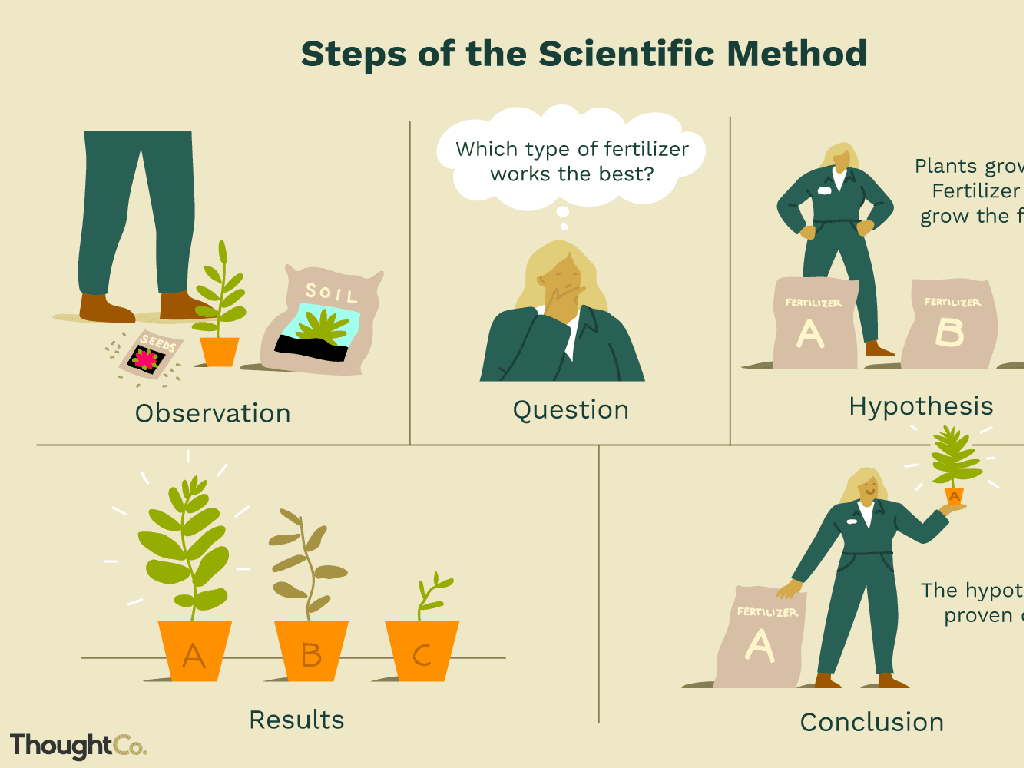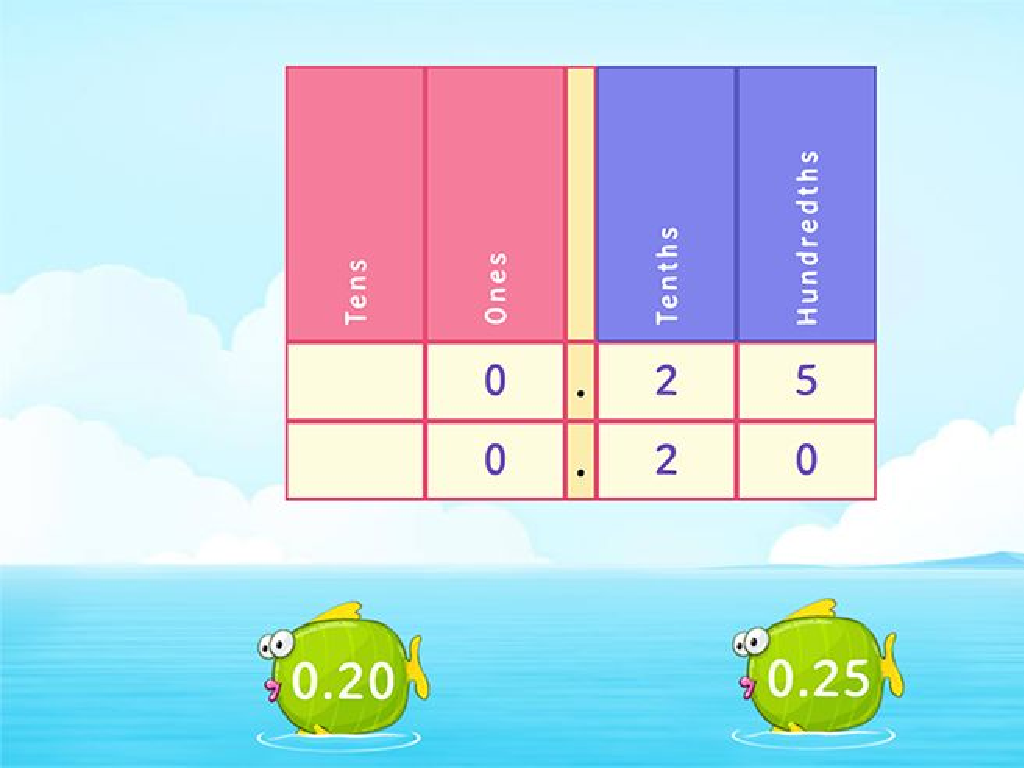Identify Ecosystems
Subject: Science
Grade: Eighth grade
Topic: Ecosystems
Please LOG IN to download the presentation. Access is available to registered users only.
View More Content
Exploring Ecosystems: Our Environmental Tapestry
– Defining an ecosystem
– An ecosystem is a community of living organisms interacting with their environment.
– Components of ecosystems
– Includes biotic (living) and abiotic (non-living) elements.
– Varied ecosystem examples
– Examples: Rainforests, deserts, coral reefs, and urban areas.
– Significance of ecosystems
– Ecosystems maintain balance and support life on Earth.
|
This slide introduces students to the concept of ecosystems within the broader context of environmental science. Begin by defining an ecosystem as a complex network of living organisms (plants, animals, and microbes) and the physical environment (soil, water, and air) interacting as a system. Highlight the importance of both biotic and abiotic components and how they work together to form an ecosystem. Provide relatable examples of ecosystems, such as the local park (urban ecosystem), a nearby forest, or a coral reef, to help students visualize and understand the diversity of ecosystems. Emphasize the critical role ecosystems play in sustaining life on Earth, maintaining ecological balance, and the services they provide to humanity. Encourage students to think about how different ecosystems function and the importance of preserving them.
Key Components of Ecosystems
– Understanding Biotic Factors
– Biotic factors are all living things in an ecosystem, like plants and animals.
– Exploring Abiotic Factors
– Abiotic factors include non-living elements like water, sunlight, and soil.
– Interactions in Ecosystems
– Species interact with each other and with abiotic factors for survival.
– Ecosystem Balance
– A stable ecosystem maintains a balance between its biotic and abiotic components.
|
This slide aims to introduce students to the complexity of ecosystems by breaking down their key components. Biotic factors refer to all the living organisms within an ecosystem, which can range from bacteria and fungi to plants and animals. Abiotic factors are the non-living parts of an ecosystem that influence living organisms, including sunlight, temperature, water, and soil. Students should understand how these components interact, for example, how plants (biotic) need sunlight and water (abiotic) to grow. The balance within ecosystems is crucial for the survival of the species within them, and any significant changes to biotic or abiotic factors can disrupt this balance. Encourage students to think of local ecosystems and identify the biotic and abiotic factors within them.
Exploring Types of Ecosystems
– Terrestrial Ecosystems Overview
– Forests, deserts, grasslands with distinct climates and life
– Aquatic Ecosystems Overview
– Freshwater (lakes, rivers) and marine (oceans, coral reefs)
– Unique Features of Ecosystems
– Forests: dense trees; Deserts: dry, sparse; Grasslands: open, grassy
– Importance of Ecosystem Diversity
– Ecosystems support various life forms and maintain balance
|
This slide introduces students to the concept of ecosystems, focusing on the two main types: terrestrial and aquatic. Terrestrial ecosystems include forests, which are characterized by a high density of trees; deserts, known for their arid conditions and sparse vegetation; and grasslands, which are dominated by grasses and have few trees. Aquatic ecosystems are categorized as freshwater, which includes rivers and lakes, and marine, which includes oceans and coral reefs. Each ecosystem has unique features that support different types of life. Emphasize the importance of biodiversity and how each ecosystem plays a crucial role in the global environment. Encourage students to think about how the different features of each ecosystem affect the organisms that live there and the importance of preserving these natural habitats.
Food Chains and Food Webs in Ecosystems
– Roles: Producers, Consumers, Decomposers
– Producers make food, consumers eat it, decomposers break down waste.
– Energy Flow in Ecosystems
– Energy starts with the sun, moves to producers, then consumers.
– Organisms’ Interdependence
– Species rely on each other for food, shelter, pollination.
– Food Webs vs. Food Chains
– Food webs show complex networks; chains show linear relationships.
|
This slide introduces the fundamental concepts of food chains and food webs within ecosystems. It’s crucial to explain the roles of producers (like plants), consumers (animals that eat plants or other animals), and decomposers (organisms that break down dead material). Highlight how energy flows from the sun to producers and through the food chain to consumers and decomposers. Discuss the interdependence of organisms within an ecosystem, emphasizing the importance of each role in maintaining balance. Differentiate between food chains and food webs, explaining that food webs are more complex and realistic representations of feeding relationships in nature. Encourage students to think of examples within local ecosystems and consider how the removal of one organism can impact the entire system.
Exploring Local Ecosystems
– Identify community ecosystems
– Explore different ecosystems within our own community, like parks or ponds.
– Observing ecosystems: key aspects
– Look for biotic and abiotic elements, species interactions, and energy flow.
– Human impact on local ecosystems
– Assess how human activities affect the balance and health of these ecosystems.
– Class activity: ecosystem exploration
|
This slide aims to engage students in understanding and identifying the ecosystems that exist within their own community. Encourage them to think about the variety of living organisms (biotic factors) and non-living elements (abiotic factors) they might find in a local park, pond, or even their schoolyard. Highlight the importance of observing interactions between species and the flow of energy through the ecosystem. Discuss the role humans play in these ecosystems, including both positive and negative impacts, and how we can contribute to their health and sustainability. For the class activity, plan a field trip or a guided walk around the school to observe these concepts in action. Provide worksheets for students to record their observations and reflections on human influences. This hands-on experience will help solidify their understanding of ecosystems.
Threats to Ecosystems
– Human impacts on ecosystems
– Pollution, deforestation, and urbanization alter habitats
– Invasive species threat
– Non-native species can outcompete local flora and fauna
– Biodiversity loss
– Reduction in the variety of life in ecosystems
– Conservation and protection
– Efforts like protected areas and sustainable practices
|
This slide addresses the various threats that ecosystems face, emphasizing the role humans play in these challenges. Human activities such as pollution, deforestation, and urbanization can significantly alter and damage natural habitats. Invasive species, often introduced by human actions, can disrupt local ecosystems by outcompeting native species. This can lead to a loss of biodiversity, which is the variety of life within an ecosystem, and is crucial for its health and resilience. Highlight conservation efforts, such as the establishment of protected areas, wildlife sanctuaries, and the promotion of sustainable practices, which are vital in mitigating these threats and preserving ecosystems for future generations. Encourage students to think about how their actions can impact the environment and discuss ways they can contribute to conservation efforts.
Class Activity: Ecosystem Exploration
– Form groups to discuss ecosystems
– Choose an ecosystem to research
– Consider factors like climate, biodiversity, and human impact
– Prepare a group presentation
– Include information on species, food chains, and conservation
– Share findings with the class
|
This activity is designed to engage students with their local environment by researching and presenting on an ecosystem. Divide the class into small groups and allow them to select a local ecosystem to study, such as a forest, wetland, or urban park. Encourage them to consider various aspects like climate conditions, types of species present, and human influences. Each group should prepare a short presentation covering the ecosystem’s characteristics, including the food chain and any conservation efforts. This will help students understand the complexity and importance of ecosystems. Provide resources such as books, documentaries, and internet access for research. Possible activities: 1) Field trip to a local ecosystem, 2) Creating a diorama, 3) Interviewing a local ecologist, 4) Building a food web, 5) Researching the impact of human activities.
Ecosystems: Conclusion and Reflection
– Recap ecosystem components
– Producers, consumers, decomposers, and their interactions
– Discuss ecosystems’ importance
– Ecosystems support life, maintain balance and biodiversity
– Reflect on today’s activity
– Share personal learnings
– Think about how ecosystems affect your daily life
|
As we conclude today’s lesson on ecosystems, it’s important to review the key components that make up an ecosystem: producers, consumers, and decomposers, and how they interact with each other. Emphasize the critical role ecosystems play in supporting life on our planet, maintaining ecological balance, and preserving biodiversity. Reflect on the activities conducted in class to reinforce these concepts. Encourage students to share what they’ve learned and how this knowledge can be applied to their understanding of the natural world. Ask them to consider the impact of ecosystems on their daily lives and the importance of conservation efforts.






